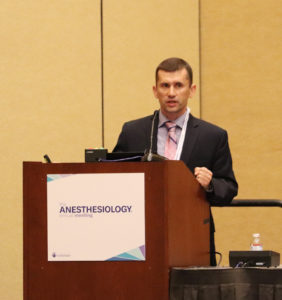Extremely challenging situations can develop in the O.R. that affect what happens in the ICU later on. But the more familiar you are with the core tenets of ICU management, the better prepared you’ll be when challenging situations happen. That was the premise of the Sunday session “Intraoperative Critical Care: How to Best Succeed When All Seems Lost.” It offered best practices for managing the most challenging populations: patients with pulmonary embolism (P.E.), severe aortic stenosis undergoing noncardiac surgery and intraoperative cardiac arrest. How can you resuscitate the patients and positively impact their neurologic outcome?
“It’s a myth that VTE prophylaxis eliminates pulmonary embolism,” said Roman Dudaryk, M.D., from the Department of Anesthesiology at the University of Miami.

Roman Dudaryk, M.D., offered best practices for managing the most challenging populations.
To intraoperatively manage patients suspected of P.E. in the O.R., Dr. Dudaryk emphasized that the size of the embolism matters. Patients with a massive P.E. will present with hypoxia and a degree of early dysfunction.
Dr. Dudaryk asserts that “if you see early dysfunction in a patient at high risk for P.E., it’s most likely PE. Don’t quit doing aggressive CPR.”
To manage these patients successfully, it’s important to maintain right ventricular output. He notes that “norepinephrine is the best agent to do that.”
Fortunately, “cardiac arrests during surgery don’t happen with the same frequency they used to,” said Craig S. Jabaley, M.D., Department of Anesthesiology at Emory University, Atlanta. Dr. Jabaley discussed best practices for optimizing outcomes for intraoperative cardiac arrest patients.
Cardiac arrest in the O.R. is down tenfold since 1970, numbering one in every 10,000 adults. Still, some populations are vulnerable, including the elderly. Dr. Jabaley recommended preparing for cardiac arrest with O.R. crisis checklists and emergency manuals to help everyone perform in a clinical environment.
“End-tidal carbon dioxide is paramount for the detection of ROSC,” he said.
There’s a strong association between the two. After surgery, hypothermia must be avoided. If patients are in a deep coma after cardiac arrest, Dr. Jabaley recommended maintaining them at 33 to 34 degrees Celsius for 24 hours. For patients with some degree of motor response, maintain their body temperature at 36 degrees for 24 hours. Both of these practices can “help get your patient’s brain back.”
Neurologic injury is the main cause of mortality and eventual morbidity and functional limitations in survivors. Unlike cardiac arrest in the O.R., “aortic stenosis is rising in the population,” said J. Ross Renew, M.D., Department of Anesthesiology and Perioperative Medicine at the Mayo Clinic in Jacksonville, Florida.
Dr. Renew wrapped up the session with recommendations for managing severe aortic stenosis with patients undergoing non-cardiac surgery. Aortic stenosis occurs in nearly 10 percent of patients in their 80s. The current recommendation of postponing surgical intervention until severe aortic stenosis is corrected seems to be overly conservative and may delay necessary non-cardiac surgery.
If patients undergoing non-cardiac surgery with severe aortic stenosis are asymptomatic, elective non-cardiac surgery is likely safe.
Aortic stenosis correction should be considered for patients with symptomatic aortic stenosis before non-cardiac surgery.
Return to Archive Index